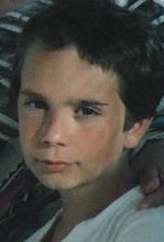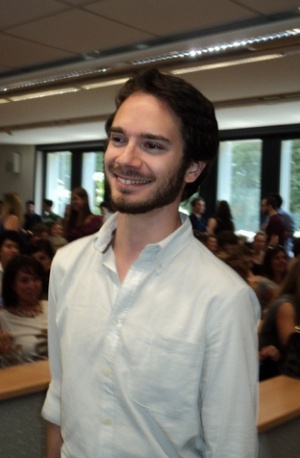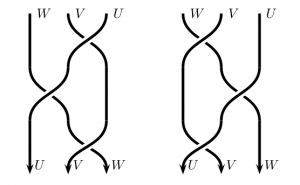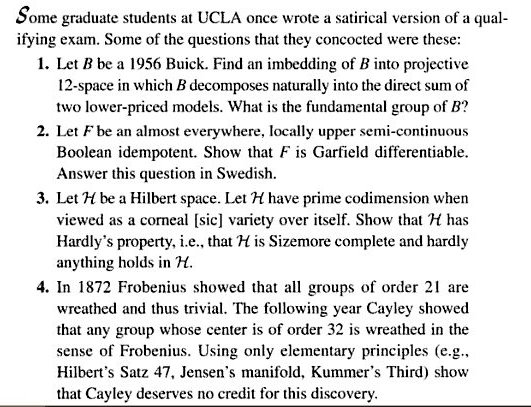User:Eotvos
Someone on internet knows me as Eotvos, others know me as tetrapharmakon. However my best avatar (grasping my whole intention and personality) is killing_buddha.
I am an italian mathematician who lived in Padua, Italy, until now, and then moved to Trieste beginning its first attempt to conquer the world. My scientific interests are pretty wide, I spend much time reading about category theory, universal algebra, differential geometry, algebraic geometry, homotopy theory, and geometry inspired by high energy physics. I've ever been fascinated by the epistemological problem of figuration of space: I still hope to find out a coherent geometrical model of Borges' Library of Babel. At the beginning of my student life, I chose to study Geometry, and Algebra therefore, for a simple reason. When I was still a child, I dreamed to become an artist, a painter or a sculptor. Later I discovered Mathematics, and I found out the same feelings through the infinitely malleable and ideal shape of a manifold, or the polished and perfect matter which Riemann surfaces are made of. When I have a pencil or a chalk in my hand, when I write on a blank sheet or a blackboard, when I plot a graph or I draw a commutative diagram, then I feel the same artistic sensations.
With the passing of time, Mathematics revealed me the deep and majestic identity between the shape of an object (its geometrical nature, its physical and plastic properties) and its gist (its purest essence, its algebraic and axiomatic construction). Following Klein's point of view, for example, I can perceive that what we call a geometry is nothing else than the result of applying the action of a suitable group over an appropriate set: on changing the shape of a space, we modify the relationships among the objects, not really caring about the objects themselves. Moving its early steps from a basic intuition (i.e., the identity principle), Mathematics elevates itself focusing on the relations among a wider spectrum of entities, whereas it is important the way in which the objects at hand are related to each other and not their particular nature.
This point of view culminates, IMHO, in the mathematical theory of categories.
The leading idea wherewith Category Theory looks at Mathematics is subordinate the nature of the entities to the chance of linking them in a (sensible) web of mutual relations. Roughly speaking, one forgets about the static nature of objects, unraveling the dynamical ways it is modified by the action of external transformations (we call them morphisms). Starting from a very basic idea (the identity principle between entities in a "bunch"), we elevate to a more subtle one, the idea of relation between "things in the bunch". Mathematically speaking, we are witnessing a huge turnaround: the primeval ideas of set and element, introspective by their nature (a set is characterized by its elements), is no longer enough to completely describe those "systems" not fitting into this too introspective setting. Because of this we move studying "objects" in a leibnizian way, giving a number of external relations between "indivisibles", in a family which gathers all the objects subject to a suitable intensional definition (in fact minding some foundational hardships).
Certainly this point of view may appear unnecessarily and unpleasantly smoky: the interested reader may profit of an analogy from linguistics. The concrete side of a language is its semantics, the practical use of phonemes to recognize a precise object, astraying it from the context (the "universe"); synthax fulfils its abstract side, explaining relations between objects, minding their interdependence. What's worth in talking is not what words are, but how words relate each other.As a matter of storiography, one could find in the seminal work of Eilenberg and Mac Lane General Theory of Natural Equivalences the birthday of the basic definition of category, functor, natural transformation et cetera. but (and it happens everytime one tries to date back an event) I likely believe that these ideas are much more ancient. One can in fact date back the origin of a "categorial" (=structuralist) point of view in Mathematics in Felix Klein's talk Vergleichende Betrachtungen über neuere geometrische Forschungen (Comparative observations on recent geometric research), with which (as I said before) we began to call a geometry the mere specification of a group action on a set of objects, whose nature is never investigated. Nothing matters but the orbit-spaces, and a "geometric property" in defined to be any property which is invariant under that action. Two objects are equal up to isomorphism if and only if the are linked by a suitable invertible transformation in the group which identifies our "geometry", or rather our structure (projective linear transformations, holomorphic maps, bijections, reflections, canonical transformations, monotone mappings, ...).
It's worth mentioning that even Poincaré said that "[...] les mathématiciens n'étudient pas des objets, mais des relations entre les objets; il leur est donc indifférent de remplacer ces objets par d'autres, pourvu que les relations ne changent pas." (La Science et l'hypothèse, 1902): so it's far from surprising that similar ideas had slowly but constantly permeated any other humanistic and scientific discipline, touching Sociology and Literature, with Propp's Morphology of the Folktale, and even Philosophy, Linguistics and Psychology with the advent of the structuralist school.
Stuff I wrote (mainly Mathematics, mainly in Italian)
- Notes on elementary Differential Geometry; the study of the Geometry of curves and surfaces culminates with Gauss' masterpiece Disquisitiones generales circa superficies curvas, where he defines the concept of intrinsical geometric property. Can a small ant lying on a cylinder notice it is walking on a globally non-flat surface? And what if it was on a sphere? And what if it was on a torus?
- Lecture notes about Riemann surfaces; A Riemann surface can be characterized as a complex one-dimensional manifold: asking the transition functions between charts to be (bi)holomorphisms between domains of the complex line obstructs the general (even smooth) two-dimensional manifold to be a RS. Algebraic, analytical and geometrical methods work in sinergy to give a beautiful and (at least in the case of compact spaces) complete theory.
- My (undergraduate) thesis in Category Theory; the main result is the so-called Beck's monadicity theorem: Huber proved in 1961 that any pair of adjoint functors F ⊣ G gives rise to a suitable monad (GF, GεF), η). Hilton rapidly conjectured that every monad arises from a suitable pair of adjoint functors. This turns out to be "essentially" true, thanks to Kleisli (1965) and Eilenberg-Moore (1965), who independently proved this theorem exhibiting two extremal ways to factor the endofunctor T of a given monad M in the product of two mutually adjoint functors FM ⊣ GM: the collection of all the ways to factor T can be organized in a (rarely small) category, whose initial object is Klesli's adjunction, and whose terminal one is Eilenberg-Moore's. In particular for any adjunction factoring a given monad there is a unique functor Φ form the domain of the right adjoint to the Eilenberg-Moore category; we call this right adjoint monadic iff Φ is an equivalence. Beck's Theorem allows us to recognize monadic functors between those who in a suitable sense respect some particular diagrams called "forks". Useful fact: in any adjunction Mon ⊣ Sets, Grp ⊣ Sets, Ab ⊣ Sets the forgetful functor is monadic.
- A note on derived functors; Homological Algebra firmly arose as the Golden Bridge between Algebra and Geometry. This brief note is intended to prepare the notion of derivative of a functor between abelian categories with "lots" of injective/projective objects. Exposition then turns to a sheaf-theoretic application of the theory, lying on the following fundamental result: The category Sh(C) is abelian/has lots of injectives provided C is abelian/has lots of injectives. (In fact for time reasons I stopped to some categorical properties of Sh(X), the category of sheaves on a space; someday I'll finish...)
- Tentative complements on functorial topology and A short introduction to triangulated categories; The first reason I chose to study Mathematics is Algebraic Topology. Despite the intrinsic complexity of the topic, I can't abandon the idea that this is the most elegant way to look at Geometry, so with the passing of time I cared to refine my understanding about homotopy theory, homological algebra and suchlike, accepting that the main reason Category Theory was invented is to turn Algebraic Topologist's deliria into rigorous statements. The "tentative complements" arose with two short-term goals, but rapidly fell off to become the draft of a draft: 1) explicitly solve some exercises nobody publicly solves (they're often left to the conscious reader) and 2) give a categorical flavour even to basic statements on both General and basic Algebraic Topology. The "short intro" arose to extend and publicly propose one of the cornerstones in advanced Homlogical Algebra: triangulated categories.
- Sparse notes on Hamiltonian Mechanics; My first love is Mathematical Physics, I cannot hide it. In writing these poor and chaotic pages I wanted to give myself some sort of glossa about basic mathematical methods used in Physics; in fact there's neither something original, nor something new in them, and I should have hidden them to your eyes if I had wanted to avoid a bad impression. But I definitely fell in love with Wheeler's idea that "Physics is [a part of] Geometry", and I'm fascinated by the ill genius of A. Fomenko, so I can't quit my quixotic quest for a rigorous foundation of Mathematical Physics...
- ...Indeed, even the strongest passion can be destroyed by the wrong person. I tried to attend a course in (ultra-basic) Quantum Mechanics and Theoretical Physics to restore my faith in humanity, and in the fact that in the end even a Physicist can manage profound mathematical ideas; results have been disastrous, but I can say I collected a couple of good ideas:
- A short summary about topological-group-theoretic properties of classical Lie groups of matrices;
- A short note about the Lorentz group;
- A bunch of questions:
- What's the real mathematical sense behind the existence of spin?
- How can one mathematically translate the fact that a certain ψ(x) is the wavefunction of a system of "identical particles"?
- Physicists tend to show Stokes' theorem using a engineering approach; unfortunately, it prevents them from looking at a result so deep in the right way. What if we can give the collection of suitably-smooth, suitably-oriented submanifolds of a manifold M an "additive" structure in such a way that Stokes' theorem can be stated as an "adjointness" between the ∂ operator and the eterior derivative d: 〈∂M,ω〉 = 〈M,dω〉? In fact Algebraic/Differential Topology is not new in endowing a (possibly large) collection of spaces with an additive structure: topological K-theory is built up on a similar idea: the set of all vector bundles on the same base-space can be endowed with two operations (Whitney sum and tensor product of bundles) turning it into a semiring. The additive monoid of this semiring can be completed à la Grothendieck, giving the K0 of the space X; this approach sheds a light on various (apparently unlinked) topics in Algebraic Topology and Algebraic Geometry: one for all is cobordism theory and (functorial) TQFTs. But you know, physicists prefer to reason using small cubes in a box...
- An angry tirade against those who claim to do science without a solid foundation, promptly avoiding to dwell on the only important thing in the work of a scientist: caring details. Reactions to this piece of applied Philosophy have been various but invariably ireful; I collected a couple of (direct and indirect) answers I received: if you are Italian, then enjoy them!
- A paper by I. Bucur about the Chow ring of a variety. The topic is deeply linked to one of my my main interests, homological algebra and derived categories. The original paper was full of errors, so I decided to improve my French adding some (subtler) errors.
- A note on Galois Theory, one of the most beautiful pieces of Abstract Algebra discovered by mankind. It is indeed one of the subtlest incarnation of the mathematical notion of duality between two entities. Whenever we are interested in studying the (partially ordered) set of intermediate structure between a top-set E and a bottom-set F, we can turn to study Aut(E|F), the group of automorphisms of the top-set, fixing pointwise the bottom-set.
- A collaborative, compact but hopefully pervasive, history of Mathematics, prepared to conclude a course about foundations of Mathematics. It's neither a masterpiece, nor it contains something new, but the spirit we used to write it should be preserved. Beware! The pdf file is ~17MB.
- A note on algebraic groups, inside a course about Differential Galois Theory; one of the aims of "classical" Galois Theory is the classification of the lattice of intermediate field extensions between a base field k and a top field K. Since the very beginning of its history, mathematicians tried to apply Galois theory's ideas to the study of differential equations, instead of algebraic ones. Even the definition of Lie group has been given by S. Lie in order to try to "analytify" Galois' ideas. The main object of study in DGT is a field extension (often infinite and transcendental) K=k(z)|k, generated by a solution z of a (linear) differential equation L(z)=0.
- My (graduate) thesis, which I defended on July 18, 2012. Orlov spent lots of years studying the derived category Dbcoh(X) of coherent sheaves on a variety X; in the spirit of reconstruction theory, lots of algebraic properties of the category itself reflect into geometric properties of the space X. As an example of this, we present in Section 1.3 a theorem which can be found clearly presented in [Cal] (see References) and due to Orlov-Bondal-Kapranov: the category Dbcoh(Pn) can be presented in a "simple" way by means of suitable shifts, mapping cones and cylinders of a finite number of twisting sheaves O(n). Orlov's study culminates into the central theorem of this work: Section 2.4 is entirely devoted to a complete account of the Theorem appeared in Bondal-Orlov's paper [Orl], by means of which one can exhibit an isomorphism of varieties X ~ Y starting from an equivalence of categories Dbcoh(X) ~ Dbcoh(Y), provided the canonical sheaf/bundle of X is ample or antiample. Orlov's idea is to explicitly build a space isomorphic to X by means of suitable objects in Dbcoh(X) which play the role of its points and invertible sheaves: we are allowed to do that mainly thanks to the good behaviour of the canonical sheaf of X, and by means of (a suitable categorification of) Grothendieck-Serre duality.
- The Jacobian Mathematicians. Our name is a pun between Jacobian and Jacobins; it is intended to be some kind of open window towards the scientific attitude to knowledge. We talk about Maths, also developing its interconnection with culture and Philosophy. Here [1] an (italian) manifesto explaining our intent: students talking to other students bring their own researches on the scene. Feel free to mail me if you want to reach us; meetings "illegally" take place in Padua @math department (63, via Trieste: Google maps puts it here). I gave seven lectures until now (but three more people talked about Game Theory, Fourier analysis, and analytical solutions to PDEs):
- One Fibrations between spheres and Hopf theorem [2]
- Two The importance of being abstract aka A gentle introduction to the categorical point of view to reality [3]
- Three low dimensional Topological Quantum Field Theories [4]
- Four Chatting about complex geometry (from symplectic to Kahler manifolds) [5]
- Five Connections and Fiber Bundles [6], with a glance to the geometry of Classical Field Theory.
- Six: A short lecure about Computational Homological Algebra [7], my first piece of (!) applied Mathematics.
- Seven [indeed, yet to come]: Monoidal Categories for the working physicist [8], a tentative introduction to Categorical approach to Quantum Mechanics.
- I also know something about Mathematica(TM) and PSTricks, languages which allowed me to write some (really naif) pieces of code to:
- Draw algebraic curves and compute some of their invariants: [9]
- Compute the Christoffel symbols of a real surface
- Draw some simple links and tangles
- A Mathematica(TM) applet to work with Freedman's theorem
- Draw some simple elliptic curves and algebraic curves [10][11]



